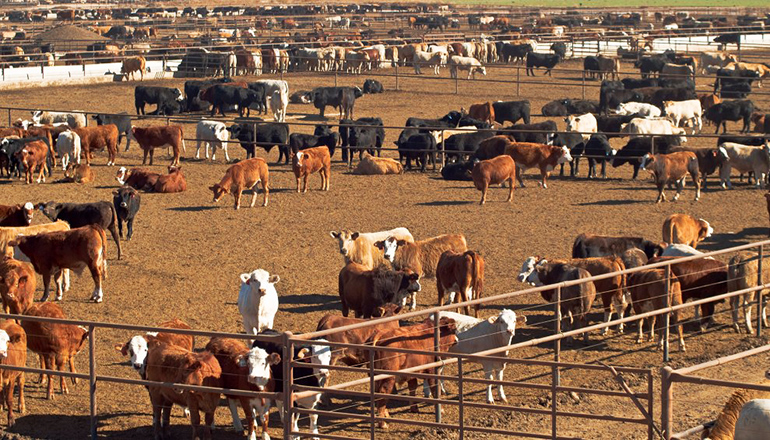At the Chicago Mercantile Exchange, except for the nearby contract, live cattle futures continued to tumble on another round of follow-through selling, with additional pressure from the volatility in the broader markets, lack of support from this week’s cash business, and weakness in wholesale values. Feeder cattle futures were sharply lower on the same factors as the live pit. February live cattle closed $.07 higher at $112.70 and April live cattle closed $2.90 lower at $107.57. March feeder cattle closed $1.30 lower at $131.27 and April feeder cattle closed $1.37 lower at $132.70.
Direct cash cattle trade activity ended the week at a standstill. There was a light to moderate trade that took place on Tuesday and Wednesday with live deals at $115 and dressed deals at mostly $187. Both were well below the previous week’s weighted average basis.
In South Dakota last week, feeder steers under 700 pounds were $2 to $5 lower and over 700 pounds were $3 to $7 lower. Feeder heifers were $3 to $8 lower. The USDA says demand was moderate to good for the week, and light flesh steers and heifers under 600 pounds were in high demand. The feeder cattle market was greatly pressured by the rapidly falling futures market. Receipts were down on the week and the year. Feeder supply included 58 percent steers and 54 percent of the offering was over 600 pounds. Medium and Large 1 feeder steers 601 to 648 pounds brought $152 to $180.50 and feeder steers 700 to 748 pounds brought $136.50 to $160.50. Medium and Large 1 feeder heifers 600 to 649 pounds brought $133 to $153 and feeder heifers 700 to 748 pounds brought $123.50 to $152.
Hay supplies in Missouri are moderate as movement has been slow. There is still a long way to go before hay feeding days are completed. Demand for hay is light to moderate and prices are steady. Supreme quality alfalfa brought $180 to $200, small squares brought $7 to $9 per bale. Premium quality alfalfa brought $160 to $180. Good quality alfalfa brought $120 to $160, small squares brought $5 to $7 per bale. Fair quality alfalfa brought $100 to $125. Good quality mixed grass hay brought $80 to $120, small squares brought $6 to $8 per bale. Fair to good quality mixed grass hay brought $60 to $80, small squares brought $3 to $6 per bale. Fair quality mixed grass hay brought $35 to $50 per large round bale and $25 to $40 per 4×5 bale. Good quality bromegrass brought $80 to $120 and fair to good quality bromegrass brought $50 to $80.
Boxed beef closed steady to lower on light to moderate demand and moderate offerings. Choice closed $.24 lower at $205.30 and Select closed $.78 lower at $198.91. The Choice/Select spread closed at $6.39.
Estimated cattle slaughter is 115,000 head – down 6,000 on the week and down 2,000 on the year. Saturday’s estimated kill is 25,000 head – down 8,000 on the week and up 4,000 on the year.
Lean hog futures ended the day lower on another around of follow-through selling and long-term demand uncertainties as demand impact from the coronavirus remain unknown. April lean hogs closed $.27 lower at $62.27 and May lean hogs closed $.72 lower at $69.02.
Cash hogs closed steady with moderate negotiated numbers. The market remains relatively optimistic that demand for US pork will continue to press higher and that’s helping to keep prices supported along with fairly strong domestic demand to start the year. However, demand uncertainties linger as the full impact from the coronavirus is unknown and the US is facing increasingly more competition on the global market from countries like Brazil. All while supplies of US pork are growing. Barrows and gilts at the National Daily Direct closed $.25 higher with a base range of $45 to $52 for a weighted average of $50.59; the Iowa/Minnesota closed $.17 higher for a weighted average of $50.24; the Western Corn Belt closed $.07 higher for a weighted average of $50.14. Prices at the Eastern Corn Belt were not reported due to confidentiality.
The USDA says early-weaned pigs were $9 per head lower and all feeder pigs were steady to weak. Demand was light to moderate for moderate offerings and receipts included 69 percent formulated prices. Total composite formula range was $40.50 to $49 for an average of $44.97. Total composite cash range was $11 to $45 for an average of $29.94. The weighted average for all early-weaned pigs was $41.04 and the weighted average for all feeder pigs was $57.25.
Midwest cash markets are closed today. At Illinois, slaughter sow prices were steady with moderate demand for moderate offerings at #17 to $26. Barrow and gilt prices were firm with moderate demand for moderate offerings at $27 to $35.
Pork values closed steady – down $.17 at $64.12. Loins and ribs were sharply lower. Butts were weak. Picnics were steady and hams and bellies closed sharply higher.
Estimated hog slaughter is 486,000 head – up 19,000 on the week and up 17,000 on the year. Saturday’s estimated kill is 91,000 head – down 101,000 on the week and down 98,000 on the year.







